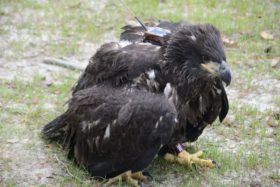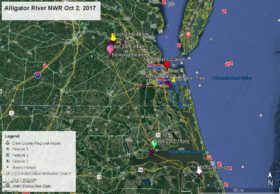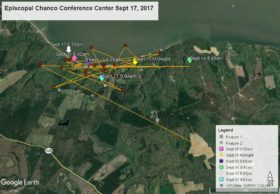Female #3 – Tongue Closeup
Azalea at Dam Neck Navy Base 5/9
May 10, 2012Camellia Exploring Old Princess Anne County 5/12
May 12, 2012This evening female #3 presented the opportunity to get some closeups of her tongue. The tongue of a bird is extremely sensitive, filled with tactile sensory corpuscles. Two features we could see were the hole in the tongue and the backward facing barbs. The hole in the tongue is the “glottis” which is the entrance to the larynx and trachea which is known as the windpipe. The glottis closes during swallowing. The barbs are called “rear-directed papillae” and aid in the swallowing of food.







7 Comments
Fascinating. Thank you Reese. And Mr. McDonald, WVEC, and other parties that make it possible to look at an eagle’s tonsils.
Terrific close-ups! I had no idea they had a “hole” in their tongue. Very interesting to read. Thank you!
Phenomenal s’caps! Thanks for teaching me even more.
Amazing photos. Thank you for giving us the chance to see these closeups of the tongue. Excellent read.
these are so cool never ever seen a bald eagles tongue so close
I know this may sound silly, but in the spirit of ‘there are no dumb questions’ I’m wondering this: Could it be possible that 5 yr. old females must build a new nest w/ their mate — instead of using an existing one — in order for them to be fertile that first year of their adult reproductive life? Could there be some physiological response to their not building a nest that renders them infertile, just during their first year of adulthood? What theories are being proposed, that you know of, for our NBG females not producing any eggs this year? Thank you.
Response – Barbara – I don’t think that the lack of building “her” own nest is the reason for no eggs this season. There was a very high incidence of the interuption of the bonding process with the constant change of nest mates. We were likely only seeing part of the replacement by the four indentified females. With sound this season we could often hear but not see what sounded like confrontations, and we do not know what happened out of camera or sound range. It is also well recognized that first year breeding bald eagles do not also produce eggs. However, we do not know everything about mate replacement, and a graduate student of Dr Bryan Watts at The Center for Conservation Biology is studying mate replacement this season, and we expect to have more answers as a result of her project.
Thanks for your response, Mr. Lukei. Would it be appropriate to ask for this grad student’s results to be shared with us on the NGB site? Maybe she could be a speaker at next year’s Eagle Fest! It’l be very interesting to find out what all went into the mate selction process this year at ‘our’ nest — and, in the general eagle population. THanks, again.